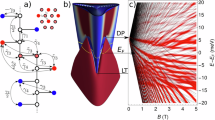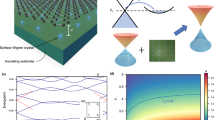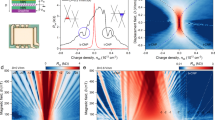Abstract
Disordered conductors with resistivity above the resistance quantum h/e2 should exhibit an insulating behaviour at low temperatures, a universal phenomenon known as a strong (Anderson) localization1,2,3. Observed in a multitude of materials, including damaged graphene and its disordered chemical derivatives4,5,6,7,8,9,10, Anderson localization has not been seen in generic graphene, despite its resistivity near the neutrality point reaching ≈h/e2 per carrier type4,5. It has remained a puzzle why graphene is such an exception. Here we report a strong localization and the corresponding metal–insulator transition in ultra-high-quality graphene. The transition is controlled externally, by changing the carrier density in another graphene layer placed at a distance of several nm and decoupled electrically. The entire behaviour is explained by electron–hole puddles that disallow localization in standard devices but can be screened out in double-layer graphene. The localization that occurs with decreasing rather than increasing disorder is a unique occurrence, and the reported double-layer heterostructures presents a new experimental system that invites further studies.
This is a preview of subscription content, access via your institution
Access options
Subscribe to this journal
Receive 12 print issues and online access
$259.00 per year
only $21.58 per issue
Buy this article
- Purchase on SpringerLink
- Instant access to full article PDF
Prices may be subject to local taxes which are calculated during checkout



Similar content being viewed by others
References
Kramer, B. & Mackinnon, A. Localization—theory and experiment. Rep. Prog. Phys. 56, 1469–1564 (1993).
Imada, M., Fujimori, A. & Tokura, Y. Metal–insulator transitions. Rev. Mod. Phys. 70, 1039–1263 (1998).
Evers, F. & Mirlin, A. D. Anderson transitions. Rev. Mod. Phys. 80, 1355–1417 (2008).
Geim, A. K. & Novoselov, K. S. The rise of graphene. Nature Mater. 6, 183–191 (2007).
Castro Neto, A. H. et al. The electronic properties of graphene. Rev. Mod. Phys. 81, 109–162 (2009).
Gomez-Navarro, C. et al. Electronic transport properties of individual chemically reduced graphene oxide sheets. Nano Lett. 7, 3499–3503 (2007).
Zhou, S. Y., Siegel, D. A., Fedorov, A. V. & Lanzara, A. Metal to insulator transition in epitaxial graphene induced by molecular doping. Phys. Rev. Lett. 101, 086402 (2008).
Bostwick, A. et al. Quasiparticle transformation during a metal–insulator transition in graphene. Phys. Rev. Lett. 103, 056404 (2009).
Elias, D. C. et al. Control of graphene’s properties by reversible hydrogenation: Evidence for graphane. Science 323, 610–613 (2009).
Chen, J. H. et al. Defect scattering in graphene. Phys. Rev. Lett. 102, 236805 (2009).
Adam, S. & Das Sarma, S. Boltzmann transport and residual conductivity in bilayer graphene. Phys. Rev. B 77, 115436 (2008).
Nersesyan, A. A., Tsvelik, A. M. & Wenger, F. Disorder effects in 2-dimensional d-wave superconductors. Phys. Rev. Lett. 72, 2628–2631 (1994).
Ludwig, A. W. W., Fisher, M. P. A., Shankar, R. & Grinstein, G. Integer quantum Hall transition—an alternative approach and exact results. Phys. Rev. B 50, 7526–7552 (1994).
Hatsugai, Y., Wen, X. G. & Kohmoto, M. Disordered critical wave functions in random-bond models in two dimensions: Random-lattice fermions at E=0 without doubling. Phys. Rev. B 56, 1061–1064 (1997).
Ryu, S. & Hatsugai, Y. Singular density of states of disordered Dirac fermions in chiral models. Phys. Rev. B 65, 033301 (2002).
Katsnelson, M. I., Novoselov, K. S. & Geim, A. K. Chiral tunnelling and the Klein paradox in graphene. Nature Phys. 2, 620–625 (2006).
Cheianov, V. V. & Fal’ko, V. I. Selective transmission of Dirac electrons and ballistic magnetoresistance of n–p junctions in graphene. Phys. Rev. B 74, 041403 (2006).
Aleiner, I. L. & Efetov, K. B. Effect of disorder on transport in graphene. Phys. Rev. Lett. 97, 236801 (2006).
McCann, E. et al. Weak-localization magnetoresistance and valley symmetry in graphene. Phys. Rev. Lett. 97, 146805 (2006).
Martin, J. et al. Observation of electron–hole puddles in graphene using a scanning single-electron transistor. Nature Phys. 4, 144–148 (2008).
Xue, J. M. et al. Scanning tunnelling microscopy and spectroscopy of ultra-flat graphene on hexagonal boron nitride. Nature Mater. 10, 282–285 (2011).
Decker, R. et al. Local electronic properties of graphene on a BN substrate via scanning tunnelling microscopy. Nano Lett. 11, 2291–2295 (2011).
Adam, S., Hwang, E. H., Galitski, V. M. & Das Sarma, S. A self-consistent theory for graphene transport. Proc. Natl Acad. Sci. USA 104, 18392–18397 (2007).
Cheianov, V. V., Fal’ko, V. I., Altshuler, B. L. & Aleiner, I. L. Random resistor network model of minimal conductivity in graphene. Phys. Rev. Lett. 99, 176801 (2007).
Dean, C. R. et al. Boron nitride substrates for high-quality graphene electronics. Nature Nanotech. 5, 722–726 (2010).
Mayorov, A. S. et al. Micrometer-scale ballistic transport in encapsulated graphene at room temperature. Nano Lett. 11, 2396–2399 (2011).
Tse, W. K., Hu, B. Y. K. & Das Sarma, S. Theory of Coulomb drag in graphene. Phys. Rev. B 76, 081401 (2007).
Ponomarenko, L. A. et al. Effect of a high- κ environment on charge carrier mobility in graphene. Phys. Rev. Lett. 102, 206603 (2009).
Ni, Z. H. et al. On resonant scatterers as a factor limiting carrier mobility in graphene. Nano Lett. 10, 3868–3872 (2010).
Tikhonenko, F. V., Horsell, D. W., Gorbachev, R. V. & Savchenko, A. K. Weak localization in graphene flakes. Phys. Rev. Lett. 100, 056802 (2008).
Tikhonenko, F. V., Kozikov, A. A., Savchenko, A. K. & Gorbachev, R. V. Transition between electron localization and antilocalization in graphene. Phys. Rev. Lett. 103, 226801 (2009).
Acknowledgements
We thank M. Katsnelson, A. MacDonald and A. C. Neto for useful discussions. This work was supported by the Engineering and Physical Sciences Research Council (UK), the Royal Society, the Office of Naval Research, the Air Force Office of Scientific Research and the Körber Foundation.
Author information
Authors and Affiliations
Contributions
R.V.G. designed the experiments; L.A.P. and S.V.M. carried out measurements; R.V.G. and R.J. fabricated the devices; L.A.P., R.V.G. and A.K.G. carried out data analysis; L.A.P., A.A.Z. and A.K.G. wrote the article. All the authors contributed to discussions. L.A.P. and R.V.G. contributed to the work equally.
Corresponding author
Ethics declarations
Competing interests
The authors declare no competing financial interests.
Supplementary information
Supplementary Information
Supplementary Information (PDF 1243 kb)
Rights and permissions
About this article
Cite this article
Ponomarenko, L., Geim, A., Zhukov, A. et al. Tunable metal–insulator transition in double-layer graphene heterostructures. Nature Phys 7, 958–961 (2011). https://doi.org/10.1038/nphys2114
Received:
Accepted:
Published:
Issue date:
DOI: https://doi.org/10.1038/nphys2114
This article is cited by
-
Electro-static properties of GaAs based two-dimensional bilayer systems
Indian Journal of Physics (2023)
-
Electronic and thermoelectric properties of group IV–VI van der Waals heterostructures
Journal of Computational Electronics (2022)
-
Strain and electric field tuning the electronic properties of two-dimensional MoS2/ScCl3 van der Waals heterostructure
Journal of Materials Science: Materials in Electronics (2022)
-
Ferroelectricity in hBN intercalated double-layer graphene
Frontiers of Physics (2022)
-
Localization to delocalization probed by magnetotransport of hBN/graphene/hBN stacks in the ultra-clean regime
Scientific Reports (2021)



